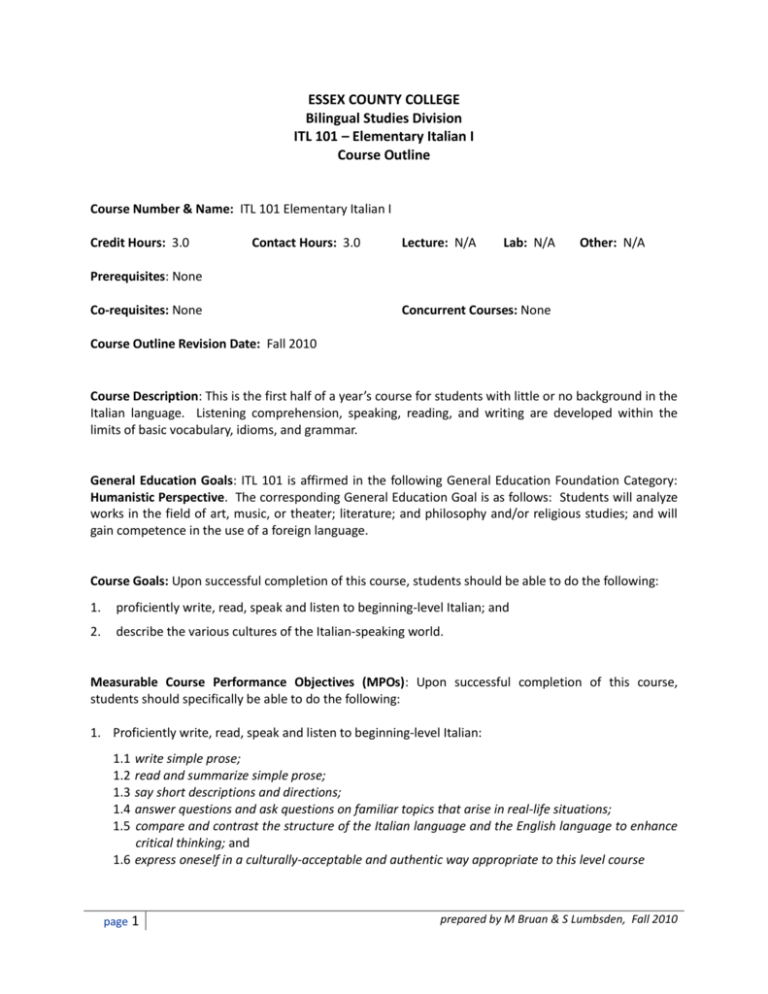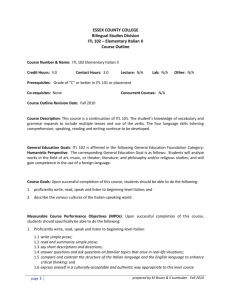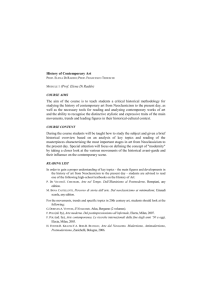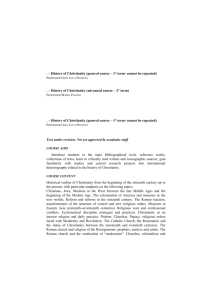Student Learning Outcomes (SLO)
advertisement

ESSEX COUNTY COLLEGE Bilingual Studies Division ITL 101 – Elementary Italian I Course Outline Course Number & Name: ITL 101 Elementary Italian I Credit Hours: 3.0 Contact Hours: 3.0 Lecture: N/A Lab: N/A Other: N/A Prerequisites: None Co-requisites: None Concurrent Courses: None Course Outline Revision Date: Fall 2010 Course Description: This is the first half of a year’s course for students with little or no background in the Italian language. Listening comprehension, speaking, reading, and writing are developed within the limits of basic vocabulary, idioms, and grammar. General Education Goals: ITL 101 is affirmed in the following General Education Foundation Category: Humanistic Perspective. The corresponding General Education Goal is as follows: Students will analyze works in the field of art, music, or theater; literature; and philosophy and/or religious studies; and will gain competence in the use of a foreign language. Course Goals: Upon successful completion of this course, students should be able to do the following: 1. proficiently write, read, speak and listen to beginning-level Italian; and 2. describe the various cultures of the Italian-speaking world. Measurable Course Performance Objectives (MPOs): Upon successful completion of this course, students should specifically be able to do the following: 1. Proficiently write, read, speak and listen to beginning-level Italian: 1.1 1.2 1.3 1.4 1.5 write simple prose; read and summarize simple prose; say short descriptions and directions; answer questions and ask questions on familiar topics that arise in real-life situations; compare and contrast the structure of the Italian language and the English language to enhance critical thinking; and 1.6 express oneself in a culturally-acceptable and authentic way appropriate to this level course page 1 prepared by M Bruan & S Lumbsden, Fall 2010 Measurable Course Performance Objectives (MPOs) (continued): 2. Describe the various cultures of the Italian-speaking world: 2.1 2.2 2.3 2.4 distinguish between the Italian spoken in the different countries of the Italian-speaking world; recognize and describe the rich, vast culture and civilization of the Italian-speaking world; discuss the influences of the Italian culture on the American society; and describe the various schedules in the Italian-speaking world Methods of Instruction: Language use is encouraged through communicative activities including videos, compact discs (CDs), Italian language computer software, group work, role-playing, games, reading assignments from the text and other sources, current events, class lectures, and discussions. Outcomes Assessment: Test and exam questions are blueprinted to course objectives. Rubrics are used to evaluate oral components of class activities and tests/exams and oral presentations for the presence and mastery of course objectives. Data is collected and analyzed to determine the level of student performance on these assessment instruments in regards to meeting course objectives. The results of this data analysis are used to guide necessary pedagogical and/or curricular revisions. Course Requirements: All students are required to: 1. Take at least four written tests on the material presented in each chapter of the textbook. 2. Become familiar with and apply correctly the minimum of grammatical forms contained in the textbook. 3. Use and spell all words and idioms covered during the semester. 4. Read with comprehension sentences taken from or similar to and based on textbook material. 5. Actively participate in classroom activities designed to enhance conversational fluency. 6. Take the final uniform departmental written examination based on a sampling material from each chapter of the reader. 7. Complete all language laboratory requirements. Methods of Evaluation: Final course grades will be computed as follows: % of final course grade Grading Components Class attendance and participation 20% Students must attend classes and participate in all class activities, which are designed to emphasize course objectives. page 2 prepared by M Bruan & S Lumbsden, Fall 2010 Methods of Evaluation (continued): % of final course grade Grading Components Homework/Oral Presentation 15% Students complete homework, which is evaluated to ensure that they are meeting course objectives. The oral presentation (if assigned) also provides evidence of student mastery of the speech components of the course objectives. 4 or more Tests (dates specified by the instructor) 40% Written and oral tests contain questions that are blueprinted to course objectives. Data analysis of the blueprinting results will provide evidence of the extent to which students master course objectives. Final Exam 25% A comprehensive final exam will provide evidence of the extent to which students have mastered course objectives and have synthesized all course material. NOTE: Students must demonstrate 70% competency on tests, dialogue and oral presentations, homework assignments, and the final exam to pass the course. In addition, students must participate actively in all group and whole class activities. Academic Integrity: Dishonesty disrupts the search for truth that is inherent in the learning process and so devalues the purpose and the mission of the College. Academic dishonesty includes, but is not limited to, the following: plagiarism – the failure to acknowledge another writer’s words or ideas or to give proper credit to sources of information; cheating – knowingly obtaining or giving unauthorized information on any test/exam or any other academic assignment; interference – any interruption of the academic process that prevents others from the proper engagement in learning or teaching; and fraud – any act or instance of willful deceit or trickery. Violations of academic integrity will be dealt with by imposing appropriate sanctions. Sanctions for acts of academic dishonesty could include the resubmission of an assignment, failure of the test/exam, failure in the course, probation, suspension from the College, and even expulsion from the College. page 3 prepared by M Bruan & S Lumbsden, Fall 2010 Student Code of Conduct: All students are expected to conduct themselves as responsible and considerate adults who respect the rights of others. Disruptive behavior will not be tolerated. All students are also expected to attend and be on time for all class meetings. No cell phones or similar electronic devices are permitted in class. Please refer to the Essex County College student handbook, Lifeline, for more specific information about the College’s Code of Conduct and attendance requirements. page 4 prepared by M Bruan & S Lumbsden, Fall 2010 Course Content Outline: based on the text Avanti! Beginning Italian, 2nd edition, by Janice M Aski and Diane Musumeci; published by McGraw Hill, NY, 2009; and the Workbook/Laboratory Manual to Accompany Avanti! 2nd edition by Janice M Aski and Diane Musumeci; published by McGraw Hill, NY, 2009 Week Content 1 Introduction and explanation of class syllabus Per cominciare Stratgie di comunicazione: Ciao/Buon giorno/Buona sera – Greeting someone; Come ti chiami?/Come si chiami? Di dove sei? – Finding out where someone is from Lessico: A come amore B come buon giorno; Alphabet and pronunciation Strutture: Maschie o femminile; Un cappuccino, per favore; Due cappuccino, per favore Unit 1, Capitolo 1 Cultura: Ascoltiamo! I gesti italiani: How to speak Italian without saying a word; Leggiamo! Italian famosi Scribiamo! Mi piacciano puzzle 2 Per cominciare Strategie di comunicazione: Ciao/Arrivederci – Saying goodbye; Ti piaci…? Le piaci…? – Expressing likes and dislikes; Sei italiano/a? E italiano/a? – Asking someone’s nationality Lessico: I mesi e le stagioni: months and seasons; I numerida 0 a 9.999: numbers from 0 to 9,999 Strutture: L’università è fantastica; Definite articles; Mi piacie l’italiano! The verb placer Unit 1, Capitolo 1 Cultura: Parliamo! Bla, bla, bla; Guardiamo! Mimi metallurgico ferito nell’onore 3 Com è? Strategie di comunicazione: Come stai?/Come sta?/Come va? – Asking how someone is Lessico: Sono allegro! Describing people, places and things Strutture: L’italiano é divertente! Adjectives; Cuanti anni hai? The verbs essere (to be) and avere (to have) Unit 2, Capitolo 2 Cultura: Ascoltiamo! I cognomi degli italiani; Leggiamo: Siamo europei! Scriviamo! Cerco compagno/ a di casa; Parliamo! Amnesia totale! Guardiamo! Nuovo Cinema Paradiso 4 Strategie di comunicazione: Sei italiano/a? E italiano/a? – Asking someone’s nationality Lessico: Describing people, places and things Strutture: Cosa c'è nello zaino? There is, there are Unit 2, Capitolo 2B Review and Test I 5 Cosa ti piace fare? Strategie di comunicazione: Sente, scusa/ Senta, che hora è? Lessico: Che fai di bello? Strutture: Mi piace studiare l’italiano; the infinitive of the verb Unit 3, Capitolo 3A Cultura: Ascoltiamo! L’orario degli italiani; Leggiamo: Avere una doppia vita; Scriviamo! Che fa? page 5 prepared by M Bruan & S Lumbsden, Fall 2010 Week Content 6 Strategie di comunicazione: Getting someone’s attention, asking and telling time Lessico: Talking about your daily activities Strutture: Studio l’italiano; the present indicative and regular verbs; Dove vai? Irregular verbs Unit 3, Capitolo 3B Cultura: Parliamo! Il telefonino (il cellulare), che passione! Guardiamo! Nuovo Cinema Paradiso Review of Test I 7 Che bella famiglia Strategie di comunicazione: Chi sei? Chi è? Cosa fai? Cosa fa? Lessico: Che bella famiglia! Talking about your family Strutture: Porto I miel amici alta festa; Possessive adjectives; Com’è tua madre? Possessives with family members; Dove vai? Interrogatives; Cuanti anni hai? the present indicative Unit 4, Capitolo 4A Cultura: Ascoltiamo! La famiglia Italiana oggi Leggiamo: a famiglia Gonzaga nella Camera degli Sposi; Scriviamo! Una famiglia famosa Review and Test II 8 Strategie di comunicazione: Meeting people and finding out what they do for a living; Che bello! – Commenting on things and complimenting people Lessico: Che bella famiglia! Talking about your family Strutture: quanto (how much) and quale (which); Che fai nel tempo libero? the interrogatives: Sai sciare? More irregular verbs; Com’ è la tua famiglia? Adjectives; L’italiano è piu bello di ...; The comparative Unit 4, Capitolo 4B Cultura: Parliamo! Mamma! Guardiamo! Ricordati di me Il blog di Emiliano – Roma 9 A tavola! Strategie di comunicazione: Ti piacerebbe…? Le piacerebbe...? – Inviting someone to do something Lessico: Tutti a ravola; Restaurant terms and items on an Italian menu Strutture: Il piu buono; the superlative; Vuoi manguiare qualcosa? Verb + infinitive Unit 5, Capitolo 5A Cultura: Ascoltiamo! Il galateo a tavola; Leggiamo: Associazione Slow Food; Scriviamo! L buon hospite 10 Strategie di comunicazione: Grazie, ma non posso – Declining an invitation Strutture: Andiamo al ristorante; Prepositions; Compro del pane; the partitive Unit 5, Capitolo 5B Cultura: Parliamo! Che maleducati! Guardiamo! Big Night Review and Test III page 6 prepared by M Bruan & S Lumbsden, Fall 2010 Week Content 11 Il Vestiti e la moda Strategie di comunicazione: Mi puoi..?/ Mi puo? – Making polite requests Lessico: Cosa porti? – Descrbing your clothes Strutture: A stilista dà il vestito alla modela; Direct and indirect objects; Che stai facendo; Present Progressive Unit 6, Capitolo 6A Cultura: Ascoltiamo! La moda italiana; Leggiamo: Maschere italiane; Scriviamo! L’indumento magico 12 Strategie di comunicazione: Grazie, ma non posso – Declining an invitation Strutture: Cosa mi metto oggi? Reflexive verbs; Parlo bene l’italiano! Adverbs Unit 6, Capitolo 6B Cultura: Parliamo! Cosa portiamo in America? Guardiamo! Il posto Review and Test IV 13 Cosa hai fatto questo weekend? Strategie di comunicazione: Dai! – Expressing surprise, pain and so on Lessico: Il mio weekend – Talking about your weekend activities Strutture: Che hai fatto questo weekend? The present perfect regular verb Unit 7, Capitolo 7 Cultura: Ascoltiamo! La musica in Italia; Leggiamo: Una serenata misteriosa; Scriviamo! Cos’è successo? Oral Presentations 14 Strategie di comunicazione: Cos è successo? – Asking what happened Strutture: Ieri abbiamo vinto la partita The present perfect of irregular verbs; Non studio mai dopo mezzanote! Negative expressions Unit 7, Capitolo 7B Cultura: Parliamo! Le tre amiche; Guardiamo! Ciao, profesore! Il blog di Luca – Bologna 15 Review and Comprehensive Final Exam page 7 prepared by M Bruan & S Lumbsden, Fall 2010



